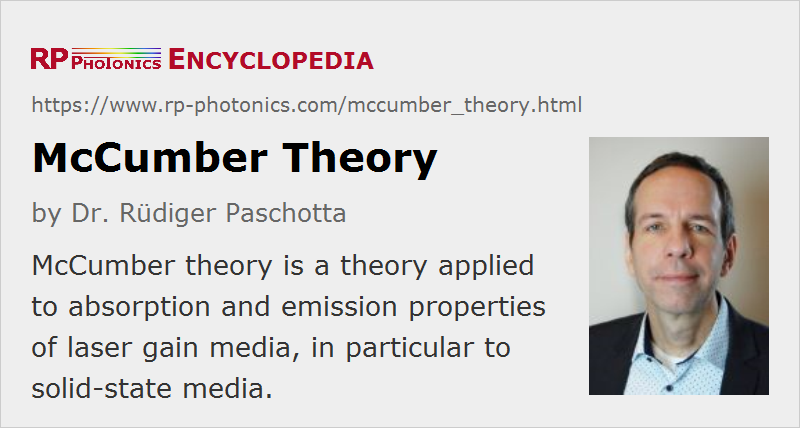McCumber Theory
Definition: a theory applied to absorption and emission properties of laser gain media, in particular to solid-state media
German: McCumber-Theorie
Category:  physical foundations
physical foundations
Author: Dr. Rüdiger Paschotta
Cite the article using its DOI: https://doi.org/10.61835/23u
Get citation code: Endnote (RIS) BibTex plain textHTML
Particularly in the context of solid-state lasers, one is often dealing with Stark level manifolds where degeneracies are lifted by the influences of the crystal field. As a consequence, absorption and emission transitions between Stark manifolds have a significant spectral width (bandwidth). The wavelength-dependent transition strengths are described with effective transition cross-sections.
In the 1960s, Dean E. McCumber at Bell Laboratories worked out a detailed theory [1] – now called McCumber theory – to explore the quantitative relations between various optical properties of laser gain media such as molecular gases but also rare-earth-doped or transition-metal-doped laser gain media. He made use of thermodynamic principles, following earlier (and less general) theoretical investigations of Albert Einstein.
McCumber theory is particularly useful for the spectroscopic evaluation of quasi-three-level laser gain media, e.g. of rare-earth-doped type. A result of central importance is the McCumber relation (or McCumber equation)
$$\sigma _{\rm{abs}}(\nu ) = \sigma _{\rm{em}}(\nu )\;\exp \left( \frac{{h\nu - E_0}}{k_\rm{B} T} \right)$$which relates the frequency-dependent effective transition cross-sections <$\sigma_\textrm{abs}$> for absorption and <$\sigma_\textrm{em}$> for emission to each other. The quantity <$E_0$>, which depends on the temperature but not on the optical frequency <$\nu$>, can be calculated from the energies of the single Stark levels, if these are known. Otherwise, one can obtain an estimate based on the assumption that the level energies within each Stark level manifold are equidistant [3]. Alternatively, <$E_0$> can be calibrated e.g. using the reciprocity method or the Füchtbauer–Ladenburg equation. For ytterbium-doped laser gain media, <$E_0$> is often close to the photon energy of the zero-phonon transition, i.e., the transition between the lowest sublevels of both manifolds.
The results of McCumber analysis are usually fairly accurate for laser crystals. However, the accuracy for rare-earth-doped laser glasses is substantially worse, particularly in cases with dominantly homogeneous broadening [4].
The McCumber relation is very useful e.g. for evaluating the weak absorption cross-sections on the long-wavelength side of a laser transition. Calculating the absorption cross-sections from the emission cross-sections can be much more precise than directly measuring the weak absorption. Also, the spectral shape of the intrinsic fluorescence can be calculated from the absorption spectrum. This can be advantageous when direct fluorescence measurements would be affected by reabsorption in a highly doped sample, or by excited-state absorption.
More to Learn
Encyclopedia articles:
- laser gain media
- four-level and three-level laser gain media
- rare-earth-doped laser gain media
- transition-metal-doped laser gain media
- effective transition cross-sections
Bibliography
| [1] | D. E. McCumber, “Einstein relations connecting broadband emission and absorption spectra”, Phys. Rev. 136 (4A), A954 (1964); https://doi.org/10.1103/PhysRev.136.A954 |
| [2] | J. N. Sandoe et al., “Variation of Er3+ cross-section for stimulated emission with glass composition”, J. Phys. D 5 (10), 1788 (1972); https://doi.org/10.1088/0022-3727/5/10/307 |
| [3] | W. J. Miniscalco et al., “General procedure for the analysis of Er3+ cross-sections”, Opt. Lett. 16 (4), 258 (1991); https://doi.org/10.1364/OL.16.000258 |
| [4] | M. J. F. Digonnet et al., “Fundamental limitations of the McCumber relation applied to Er-doped silica and other amorphous-host lasers”, IEEE J. Quantum Electron. 38 (12), 1629 (2002); https://doi.org/10.1109/JQE.2002.805111 |
| [5] | R. M. Martin and R. S. Quimby, “Experimental evidence of the validity of the McCumber theory relating emission and absorption for rare-earth glasses”, J. Opt. Soc. Am. B 23 (9), 1770 (2006); https://doi.org/10.1364/JOSAB.23.001770 |
Questions and Comments from Users
Here you can submit questions and comments. As far as they get accepted by the author, they will appear above this paragraph together with the author’s answer. The author will decide on acceptance based on certain criteria. Essentially, the issue must be of sufficiently broad interest.
Please do not enter personal data here; we would otherwise delete it soon. (See also our privacy declaration.) If you wish to receive personal feedback or consultancy from the author, please contact him, e.g. via e-mail.
By submitting the information, you give your consent to the potential publication of your inputs on our website according to our rules. (If you later retract your consent, we will delete those inputs.) As your inputs are first reviewed by the author, they may be published with some delay.



Share this with your friends and colleagues, e.g. via social media:
These sharing buttons are implemented in a privacy-friendly way!